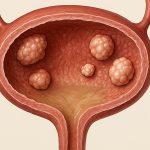Urethral polyps, though relatively uncommon, present unique challenges in urological practice due to their often subtle symptoms and potential for mimicking more serious conditions. These benign growths within the urethra can cause obstructive urinary symptoms, recurrent infections, or even be asymptomatic, leading to delayed diagnosis. Traditional diagnostic methods may struggle to accurately identify these lesions, necessitating advanced imaging and endoscopic evaluation. The increasing availability of minimally invasive techniques has revolutionized their management, offering patients less morbid alternatives to open surgery. This article delves into the current state-of-the-art treatment options for urethral polyps specifically focusing on endoscopic surgical approaches, highlighting both the technical aspects and considerations for optimal patient outcomes.
The shift towards endoscopic management stems from a desire to minimize iatrogenic complications associated with more invasive procedures. Open surgery carries risks of urethral stricture formation, fistula development, and prolonged recovery times – all factors that significantly impact a patient’s quality of life. Endoscopic techniques allow for precise polyp removal with reduced trauma to the surrounding tissues, leading to faster healing and improved functional results. The evolution of endoscopes and ancillary instruments has further refined these procedures, making them increasingly accessible and effective across varying levels of urological expertise. This approach is not merely about avoiding open surgery; it’s about delivering a superior patient experience focused on efficacy and minimal disruption.
Endoscopic Techniques for Polyp Resection
The cornerstone of urethral polyp treatment remains endoscopic resection, primarily utilizing either the transurethral resection (TUR) technique or laser-assisted techniques. TUR traditionally employed with a loop electrode, allows for precise cutting and coagulation of the polyp tissue. However, its potential to cause thermal damage and bleeding has prompted exploration of alternative methods. Laser technologies, such as holmium laser enucleation of the prostate (HoLEP)-inspired approaches adapted for urethral polyps, offer superior hemostasis and reduced risk of stricture formation. The choice between TUR and laser techniques often depends on polyp size, location, patient comorbidities, and surgeon experience. A key consideration is the potential for post-operative stricture, which remains a concern even with endoscopic methods, necessitating careful technique and potentially prophylactic measures like intermittent catheterization.
Resection typically begins with cystoscopy to visualize the urethra and identify the polyp’s characteristics – size, shape, location, and any associated inflammation. Once identified, a guide wire is often inserted through the polyp for safety and orientation. Then, using either the loop electrode or laser fiber, careful dissection and removal of the polyp are performed. The goal isn’t simply excision, but to achieve complete resection while minimizing trauma to the urethral lining. This requires meticulous technique, avoiding forceful manipulation and ensuring adequate hemostasis throughout the procedure. Post-operatively, a Foley catheter is usually placed for several days to allow for healing and reduce the risk of bleeding or obstruction.
The selection of appropriate instrumentation is critical. For larger polyps, a combination of techniques may be employed – initial laser ablation to reduce size followed by TUR for precise resection. Furthermore, advancements in flexible endoscopy have expanded the applicability of these techniques to more challenging locations within the urethra, particularly in cases where access with rigid cystoscopes is limited. This flexibility allows surgeons to navigate tortuous urethral pathways and reach polyps that were previously difficult or impossible to treat endoscopically. Patient-specific factors heavily influence technique selection, demanding a tailored approach for each case.
Preoperative Evaluation & Patient Selection
A thorough preoperative evaluation is paramount for successful treatment. This begins with a detailed patient history focusing on urinary symptoms – frequency, urgency, dysuria, obstruction, and hematuria. Physical examination should assess for any signs of underlying conditions that might influence management. Diagnostic imaging plays a vital role in characterizing the polyp and ruling out other potential diagnoses. Cystoscopy is essential not just for visualization but also for biopsy to confirm benignity. – MRI or CT scans may be utilized if there’s suspicion of more extensive disease or involvement of surrounding structures.
Patient selection is crucial, as not all urethral polyps require intervention. Asymptomatic polyps discovered incidentally may simply warrant surveillance. However, symptomatic polyps causing obstruction, recurrent infections, or significant discomfort are generally candidates for resection. Patients with a history of urethral strictures or prior pelvic surgery should be carefully evaluated due to increased risk of complications. – Preoperative optimization of underlying medical conditions such as diabetes and cardiovascular disease is essential to minimize surgical risks. A comprehensive discussion with the patient regarding the benefits, risks, and alternatives to endoscopic resection is also vital for informed consent.
Finally, it’s important to differentiate urethral polyps from other lesions that can present similarly, such as tumors or prolapsed tissue. Biopsy results are critical in confirming the diagnosis and guiding treatment decisions. – A detailed assessment of the patient’s overall health and expectations will help determine the most appropriate surgical approach and ensure realistic outcomes. This meticulous preoperative preparation sets the stage for a successful endoscopic resection and minimizes the potential for complications.
Postoperative Care & Complication Management
Postoperative care is designed to promote healing, prevent complications, and monitor for recurrence. The initial period focuses on managing catheter drainage and assessing for bleeding or infection. Patients are typically instructed to maintain adequate hydration and avoid strenuous activity during the immediate postoperative phase. Intermittent catheterization may be recommended in some cases to reduce the risk of urethral stricture formation, especially after more extensive resections. – Regular follow-up appointments with a urologist are essential to monitor urinary symptoms and assess for any signs of recurrence or complications.
Complications following endoscopic urethral polyp resection are relatively uncommon but can include bleeding, infection, urethral stricture formation, and urinary retention. Bleeding is usually minor and can be managed conservatively. Infection is typically prevented by appropriate antibiotic prophylaxis. Urethral stricture remains the most significant long-term complication, requiring further intervention such as dilation or urethroplasty. – Early recognition and prompt management of these complications are crucial to minimize their impact on patient outcomes.
Long-term follow-up is essential for detecting recurrence. The frequency of follow-up visits will vary depending on the initial polyp size, location, and presence of any risk factors. Cystoscopy may be repeated periodically to assess for new or recurrent lesions. – Patient education regarding symptoms that might indicate recurrence, such as changes in urinary habits or hematuria, is vital for early detection and intervention. Proactive monitoring and management are key to ensuring long-term success following endoscopic urethral polyp resection.
Future Directions & Technological Advancements
The field of endoscopic urethral polyp treatment continues to evolve with ongoing research and technological advancements. The development of even more refined laser systems – offering greater precision and hemostasis – promises to further reduce the risk of complications. Robotic assistance is also being explored as a potential means of enhancing surgical dexterity and visualization. – Improvements in imaging modalities, such as high-resolution endoscopes and intraoperative ultrasound, will aid in polyp detection and characterization.
The increasing use of flexible endoscopy offers exciting possibilities for treating polyps in challenging locations within the urethra. This allows surgeons to access lesions that were previously difficult or impossible to reach with rigid cystoscopes. – Research into novel techniques for preventing urethral stricture formation – such as the use of bioresorbable scaffolds or tissue engineering approaches – is also underway.
Ultimately, the goal is to develop less invasive and more effective treatment options that minimize patient morbidity and maximize long-term outcomes. Personalized medicine – tailoring surgical approach and postoperative care based on individual patient characteristics and polyp features – will likely play an increasingly important role in the future of urethral polyp management. Continued innovation and collaboration between urologists, engineers, and researchers are essential to advancing this field and improving the lives of patients affected by these lesions.





















